More Articles...
GENERAL
The event and the preparation (which means lockdowns with no permission to train and/or virtual meets) leading up to the Games was very different for Canadians and likely for other athletes as well. Certainly, the Olympics themselves were very different. Daily saliva tests, masking and no spectators were the obvious differences. Athletes were required to leave the village immediately after the competition.
The bigger difference was the limited social contact. Normally, athletes and coaches would talk to many Canadian athletes and coaches and people from other countries. In 2021, most people kept to themselves. Tourism wasn’t permitted. We knew about these changes before we left Canada. The high rise village “looked” the same as the previous 3 Olympics. However, the cafeteria had plastic panelling around each person’s eating area, so you could only really hear the people beside or directly opposite you. Our trampoline group usually found an uncrowded area and ate together, but a “group” discussion was impossible.
After over a year of spending most of my time in my house, it was weird seeing crowds of people who did not social distance. In the buffet lines, people were spaced apart by the width of a cafeteria tray! The line for sushi was even worse! Some people wore masks simply as a requirement, rather than as a precaution, with their noses uncovered.
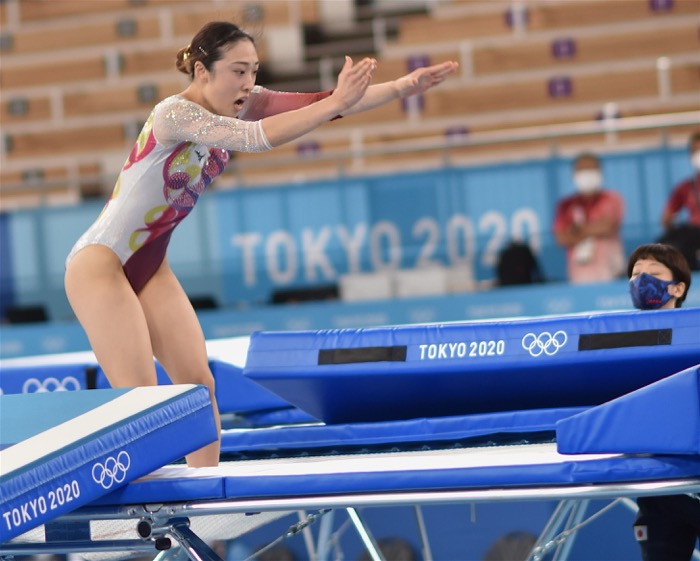
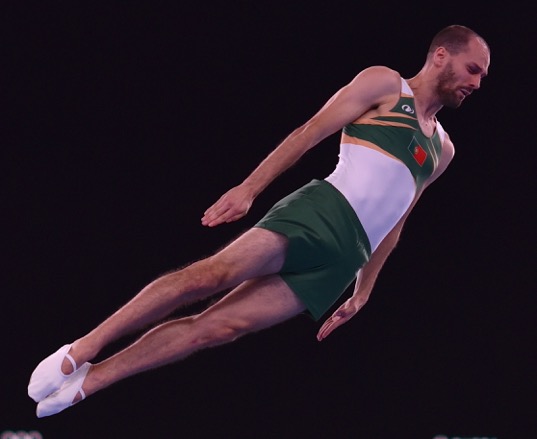
EARLY PREPARATION
ROSIE – With Rosie as a two-time Olympic champion, we knew that the media would be all over the possibility of a three-peat. We also knew that winning is never easy. At age 32, Rosie was in a field full of predominantly younger athletes. We figured we were veterans at ignoring the pressure from friends or the media, but we may have under-estimated the pressure of having the Olympics as her first live competition in 18 months.
Our goal after Rio was to increase her difficulty to become the one to beat instead of relying on others to make mistakes.
Due to the COVID-19 shutdowns, which included me not coaching Rosie (except by phone and watching video) for an entire year, it was hard to prepare properly. Many thanks to Marty who stepped in, despite risks to his family. Approximately 3.5 months before the Games, Rosie was able to complete a routine worth 15.8 difficulty using three front triples. A few weeks later, it was starting to look clean enough to be a viable option. Approximately two months before leaving for Japan, we switched from string beds to the Eurotramp 4mm bed. This was disappointing because her height dropped enough to make that choice less viable.
Rosie had been competing a routine valued at 14.9 routine at recent virtual meets. We were confident that, with 10 weeks of fine tuning, it would be competitive in Tokyo. With the scores from her previous Olympic triumphs at 15.4 and 15.0 difficulty, it was also a risky strategy. Both routines were a departure from normally routine choreography. We replaced one front skill with a back skill to elevate her potential to maintain height.
FINAL PREPARATION
Rosie seriously injured her ankle nine weeks before we left; this severely reduced the time we had for fine tuning. The outside chance of the hard routine was gone, and we would be lucky if she could even do her easy routine. This is when we really saw the value in our amazing support team; her recovery was beyond amazing. More like a miracle. Rosie kept a positive attitude and did everything she was asked. We are extremely grateful for everything everyone did to help her, and to Own the Podium for funding it all. Our strategy included not discussing her injury.
Rosie was able to do one full 14.9 optional routine just before leaving Canada. During the training camp in Japan, she slowly upped her numbers. By the time we got to Tokyo, her height was up to 0.3 seconds below pre-injury. Her best routines in training looked great. Finally, we had some real hope!
SAM – Samantha was trained in BC in recent years with Curt. She arrived in Japan very well prepared. Kudos to Sam and Curt! Sam’s participation was dependent on a procedural dispute that was settled rather close to the event. She was very excited to be an Olympian!
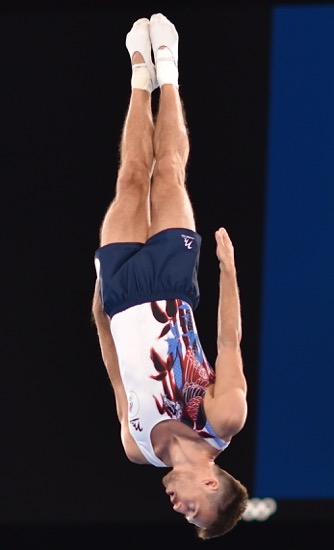
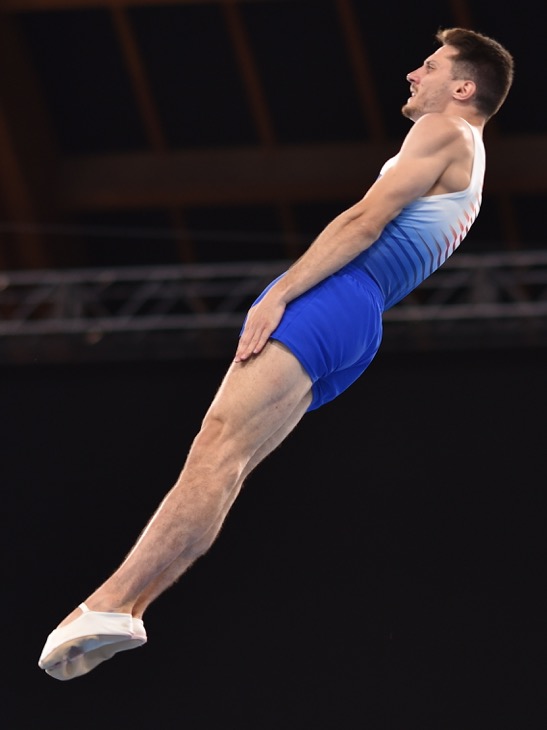
YOKKAICHI TRAINING CAMP
This was the first ever pre-Olympic training camp for Canadian trampoline in the host country. It helped with jet lag. In prior years, it was possible to get into the Olympic village for more days prior to the competition.
As much as our hosts were extremely helpful, the experience felt more like being in house arrest than a lockdown in Ontario. We traveled only to the hotel, the bus and the gym. The meals were quite healthy. The gym was big, new and clean. It was equipped with brand new actual Olympic equipment, including i-Pad instant replay on every piece of equipment!
The schedule seemed like an exercise in filling up the day. For a single two-hour training, the time between arrival at breakfast to returning to our rooms after lunch at the gym and the return bus trip was 8.5 hours. The training camp meant many extra days away from family and work.
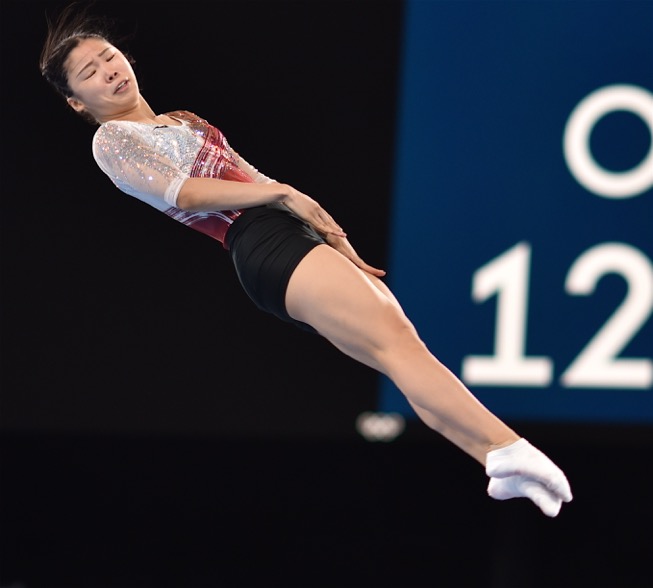
COMPETITION
By competition day, both of our Canadian competitors appeared to be very well prepared. Who would have expected that 40% of the athletes would fail to do 20 skills in the preliminaries? I would not attribute this to equipment issues. Firstly, all competitors are familiar with the Eurotramp 4mm beds, which have remained very similar for the last few years. At this meet, the feel of all the beds between the training and competition halls were similar. A few men thought both were a bit soft, but there were plenty of onsite training days. I think that there are several possible reasons for the high number of failed routines:
1) Falls happen during competitions. In recent years, the beds became more powerful and less stable, while concurrently a highly weighted score to encourage jumping high was introduced. These two factors increase the typical failure rate.
2) Athletes can suffer from feeling the weight of an entire nation’s hopes and expectations at an Olympics. For example, Mori of Japan was the reigning world champion. This was well known by the Japanese public. She trained harder than anyone and was very prepared. Unfortunately, it was obvious that she was under a lot of pressure. Apparently, she went through the mixed zone crying. I felt badly for her and all the other great athletes who didn’t complete successful routines.
3) The competition format was bizarre. There were two fake flights for compulsory routines. Each flight had an athlete march out, with each athlete named and presented to the empty seats followed by the single one-touch warm up for both routines. Both fake flights did their compulsory routines before any optional routines were performed. There was one big flight for optional routines. Athletes in the first of the two groups had approximately 48 minutes between their two routines! Training in the warmup hall with different lighting, trampolines and ambiance was permitted between routines. This system was also used in 2004 in Athens (and also produced disastrous results).
4) Due to COVID-19, most athletes had reduced training opportunities. All had reduced competition experience in the 18 months prior to the Olympic Games.
5) Athletes with injuries or training issues did not want to give up the opportunity to compete at the Olympics.
My assumption is that some combination of the above factors (and others) created a very unsettled Olympic competition.
WOMEN – Rosie made some small mistakes in each of her three performances, which she recovered from quickly, and hid quite well. Her performances were not as good as the best routines she had done in the last week of training, but they were very respectable. This was good enough for a solid fourth place finish that was breathtakingly close to the medals. The professional photos taken of her optional routines showed more of stress on her face than I am used to seeing; this indicated that the fourth factor above applied to Rosie. Regardless, this was an amazing performance for an athlete who was walking around in a boot six weeks before the Olympics!
Rosie won in 2012 with the highest difficulty. In 2016, she narrowly won with the second highest difficulty. In Tokyo, she came fourth with the fourth most difficult routine.
Sam’s compulsory routine was just as brilliant as it was during training. Unfortunately, she did not do her planned Miller at the end. It would have been the only Miller by a female at this Olympics. It looked great in training. She achieved the seventh best compulsory score. During the optional, normally her strong point, she was one of the many fine athletes who went off the rails. She over-rotated her first skill, so she almost fell off on the second one. Then she opened up far too early on the third skill, a tucked triffus. No one has a good explanation, as this had never happened to her before. In the end, a score of just under 100 was all that was needed to get into the final…making this moment even more frustrating.
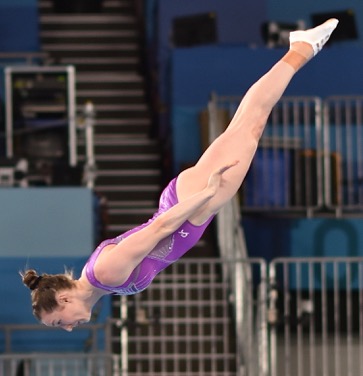
MEN – This was the first Olympics I have attended where Canada did not have a male athlete in the competition and in the running to make the finals. Thanks to Matt and Jason for all those good times! Despite also being a demolition derby, the top men showed more difficulty improvement than the top women in recent years. To make the final took an average of 17.44 difficulty.
In my opinion, the correct four athletes were in the top four spots after Gao Lei did not make the finals. It would have been interesting to see how Dominique Clark would have done if he hit his final optional routine. Apparently, Gao Lei was struggling with back problems and China was trying to substitute a young athlete instead. They could not get the replacement into Japan fast enough due to COVID-19 pre-testing restrictions. Many observers did not think Ivan should have won. In fact, Ivan himself was shocked. This is a clear indication that time of flight is far too big a factor in the total score.
Only Vlad, Dylan and all the Chinese athletes were confident enough to do easier optional routines in the preliminary rounds. It was bizarre to see Lui of China riding a motorized suitcase to avoid walking, yet she won the preliminary round and earned a silver medal.
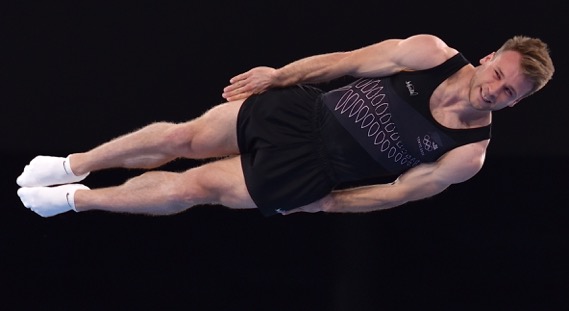
What to expect in Paris? COVID-19 is still a wildcard. The new system, with no compulsory routines, will change things slightly. I do question the safety of giving all the athletes, particularly the weaker ones, no warmup and two tries at the routine they are most likely to fail. However, in four years, the field should be stronger. Difficulty will probably rise slowly as time of flight will still be over-scored. Hopefully some athletes will use the new rules to perform different routines at different stages of the competition. However, with no rules against doing the exact same routine four times in a row at Worlds, many athletes will pick that choice. With only 10 different skills instead of 14 needed, some skills will disappear.
Comparing the scores from the last 3 Olympics, 2021 seemed to be a low scoring year. However, the new Time of Flight machines give a lower score than the old ones. This accounts for the difference.
After each Olympic cycle, some athletes retire while new stars emerge. Normally, history shows a steady increase in performance between incremental equipment and training method improvements. In addition, the top athletes are very motivated to surpass previous levels.
Will the next generation be able to keep up with the dedication of their predecessors, despite digital distractions and Covid?
The safest answer is an emphatic “yes.” Time will tell…

